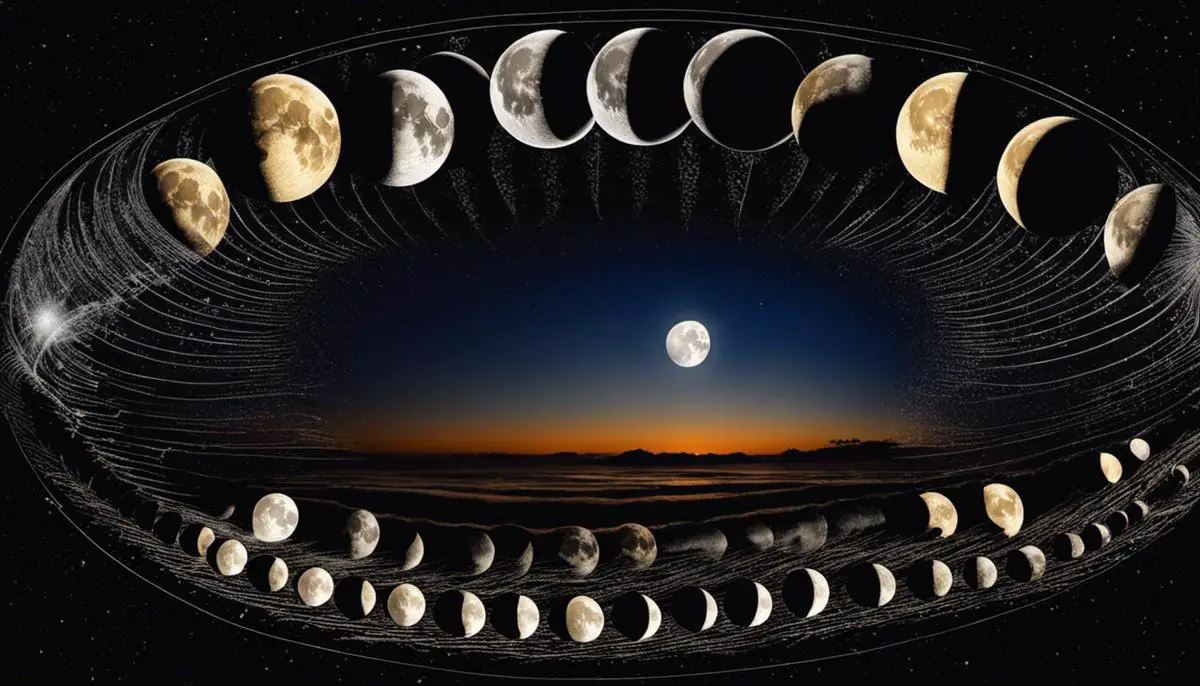As celestial wonders go, nothing quite captures our fascination and awe like the shimmering dance of the Moon against the night sky. Throughout history, these lunar phases have guided adventurers, inspired poets, and dictated the rhythm of life with their mesmerizing elegance. Our eyes can’t help but trace the enchanting transformation from an elusive New Moon to an arresting full-faced spectacle. Such is the allure of the Moon’s phases, a month-long journey that has sparked fascination across the world. This remarkable cycle is not only picturesque but also affords a wealth of knowledge about our natural world and cultural fabric. The month of September 2023 holds its unique pattern of this effectual dance, promising a celestial spectacle worth observing and understanding.
Overview of Moon Phases
Understanding Moon Phases
The Moon phases are a fascinating spectacle driven by the Moon’s orbit around the Earth and the Earth’s orbit around the Sun. As the Moon orbits the Earth, the Sun lights up varying proportions of the side of the moon that faces us. This cycle repeats every 29.5 days, a period known as a lunar month or lunation, which also introduces different moon phases including the new moon, first quarter, full moon, and third-quarter moon. New Moon marks the beginning of the lunar cycle and signifies that the Moon and the Sun are at the same celestial longitude. The First and Third Quarter Phases signify the moon appears as half-illuminated. Lastly, during the Full Moon, the entire face of the moon becomes fully illuminated.
Understanding Moon Phases for September 2023
As we examine the Moon’s progression throughout September 2023, we identify key lunar phases. On the 1st of September, the month kicks off with the First Quarter phase. This swiftly leads into the Full Moon, projected to be visible on the 8th. The Last Quarter phase follows on September 15th, and finally, the New Moon phase is forecast to take place on the 23rd. We finish the month off with a return to the First Quarter phase on the 30th of September. By understanding these phases, we can anticipate the rise and set times of the moon. For instance, a Full Moon dawns as the sun sets, while the elusive New Moon tends to rise and set alongside the Sun. Such knowledge nurtures an awareness of moon visibility in the September 2023 night sky.
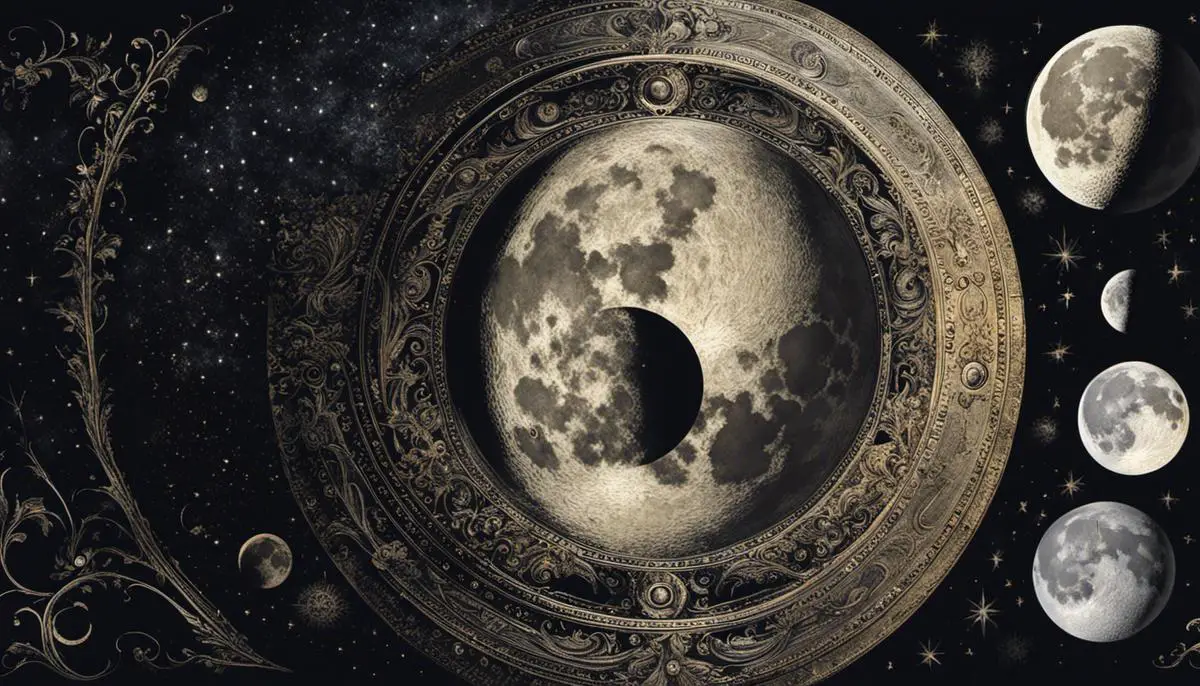
Specific Moon Phases in September 2023
Specifics of Moon Phases for September 2023
When we observe the lunar calendar for the month of September 2023, we find specific moon phases marked at distinct dates and times. The Last Quarter phase starts the month off on September 2nd at 07:37 UTC, showcasing a half-illuminated moon from Earth’s vantage and segueing into the New Moon phase.
The New Moon of September 2023 is estimated to appear on the 10th at 01:39 UTC. This phase makes the moon practically invisible from Earth due to the illuminated side of the moon facing away from us. Approximately one week later, on the 17th at 11:55 UTC, we anticipate the First Quarter phase. This phase displays another half-illuminated moon, setting course for the upcoming Full Moon phase.
Arriving on the 25th of September 2023 at exactly 23:55 UTC, the Full Moon phase offers a fully illuminated lunar disk as seen from Earth. This phase often delivers optimal nighttime visibility, creating a captivating spectacle when it occurs. As we attune to the lunar phases of September 2023, it’s important to note that day-to-day visibility and illumination of the moon will steadily evolve.
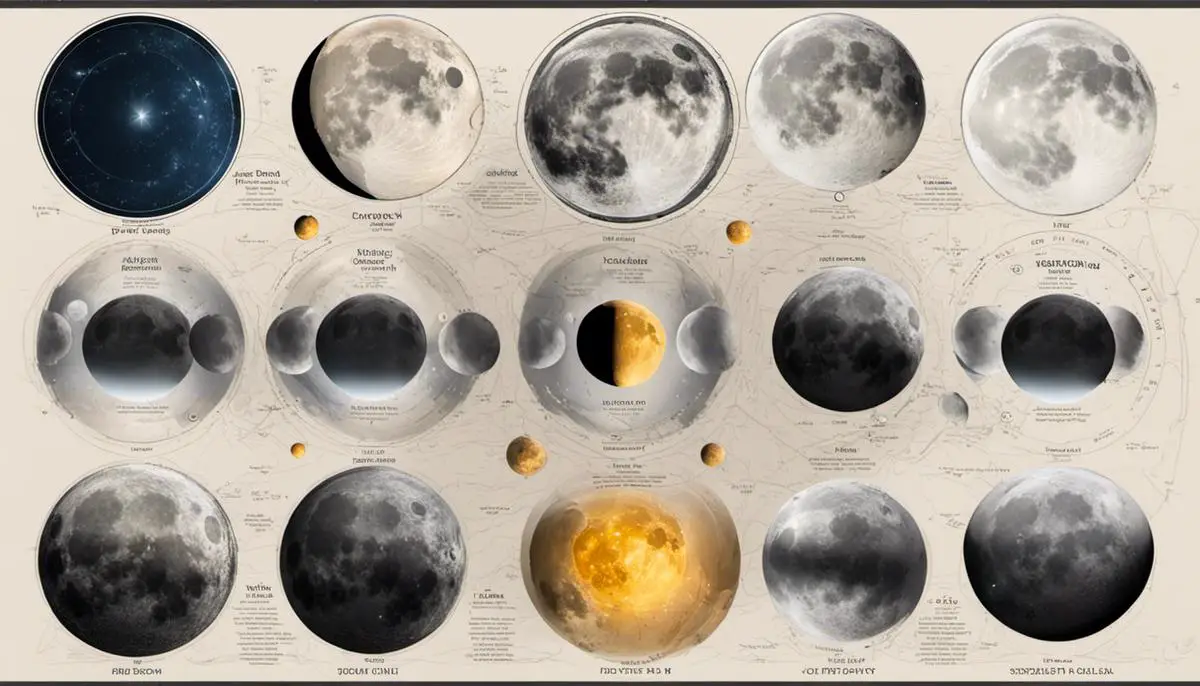
Viewing the Moon Phases
Optimal Viewing Times and Locations for Moon Observations
The moon phases for September 2023 unfold with a new moon on September 2nd, offering the darkest skies and prime conditions for exploring the stars, albeit with an almost invisible moon. Approximately a week later, on the 9th of September, the First Quarter or half-moon phase will take place. During this time, observing the moon’s craters and maria becomes especially fascinating due to the striking contrast of shadow and light on the lunar surface. Evenings are the ideal time for moon gazing in this phase. On September 16th, the full moon graces the sky with its maximum brightness and size, but the absence of shadows results in less visible detail on the lunar landscape. Viewers can best appreciate the full moon later in the evening when it is high in the sky. Locations with minimal light pollution and clear skies naturally provide more superior views.
Enhancing Your Lunar Observation Experience
The undertaking of moon watching can be considerably improved through the use of certain optical tools. Binoculars serve as an accessible starting point, providing users with a wider field of view and the ability to magnify the moon’s surface features. You would do well with a pair offering between 10x and 15x magnification. To dive deeper into the informative complexities of the moon’s surface, particularly during the half moon phase when such features become highly defined, a telescope is your best bet. A telescope capable of 75x to 150x magnification will allow you to observe the moon’s craters, mountains, and valleys in remarkable detail. Adding a lunar filter will help to temper the moon’s brightness while enhancing contrast, a feature especially useful during the full moon phase. Remember that a clear night’s sky will offer the best conditions for your lunar exploration.
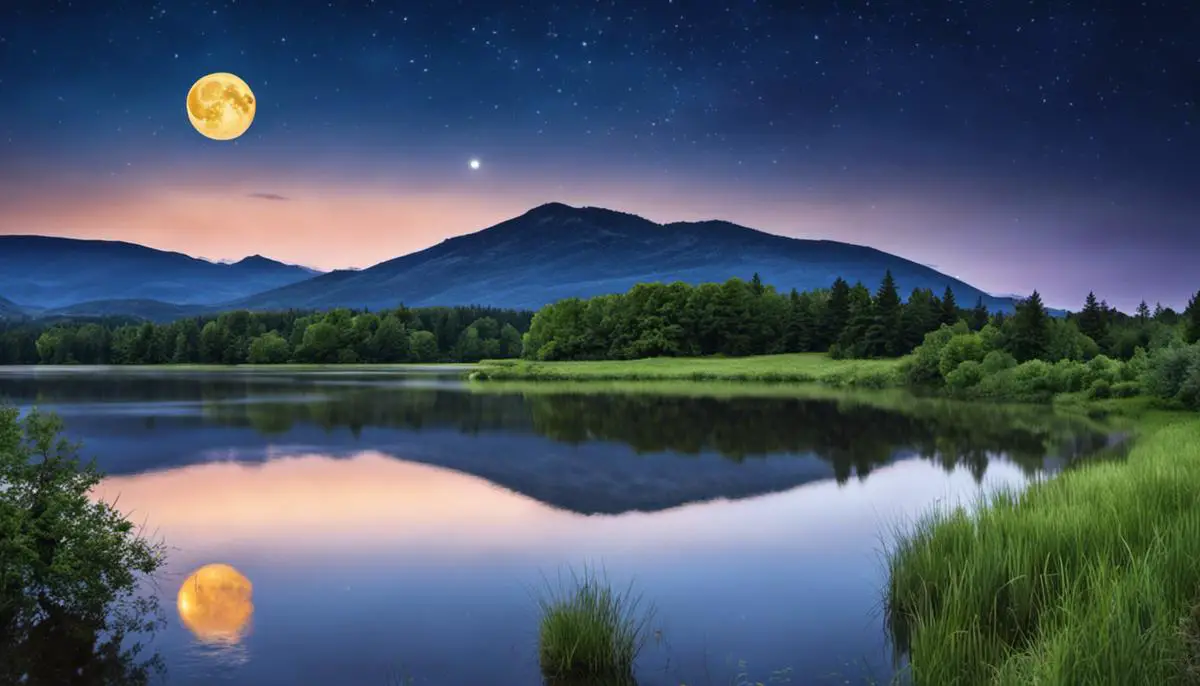
Significance of Moon Phases
The Importance of Tracking Moon Phases
The process of understanding and staying informed about the phases of the moon offers fascinating insight into the workings of our natural environment, along with practical conveniences. For example, the moon’s gravitational pull on our planet is responsible for the tidal movements, which rise and fall with the moon’s various phases. Full and new moon phases notably coincide with major fluctuations in high and low tide levels, significantly affecting marine and coastal activities globally.
In addition to these practical influences, the phases of the moon have served cultural, religious, and societal purposes throughout history. Many beliefs and practices are deeply intertwined with the lunar cycle’s different stages. Certain agricultural communities continue to align their planting and harvesting schedules with the lunar phases, while numerous cultural or religious rituals are coordinated with particular stages of the moon’s cycle.
Moon Phases and Animal Behavior
In regards to the animal kingdom, moon phases can influence specific behaviors and biological rhythms. Full moons, for instance, can trigger the spawning of coral, while new moons can stimulate the breeding of many nocturnal creatures. Certain bird species also adjust their migration and feeding habits based on the moon’s brightness. For wildlife researchers and enthusiasts, observing and understanding these behaviors is often vital.
The Importance of Tracking Moon Phases: Relating to September 2023
Just as the moon phases have implications across different aspects of life, tracking these phases can be equally significant. Accurate predictions of moon phases can prove extremely beneficial in contexts such as coastal management, agricultural planning, wildlife tracking, and even in guiding certain cultural or spiritual activities. A detailed understanding of the moon phases in September 2023, for example, can provide important practical and cultural insights for individuals and communities who maintain a close relationship with these lunar cycles.
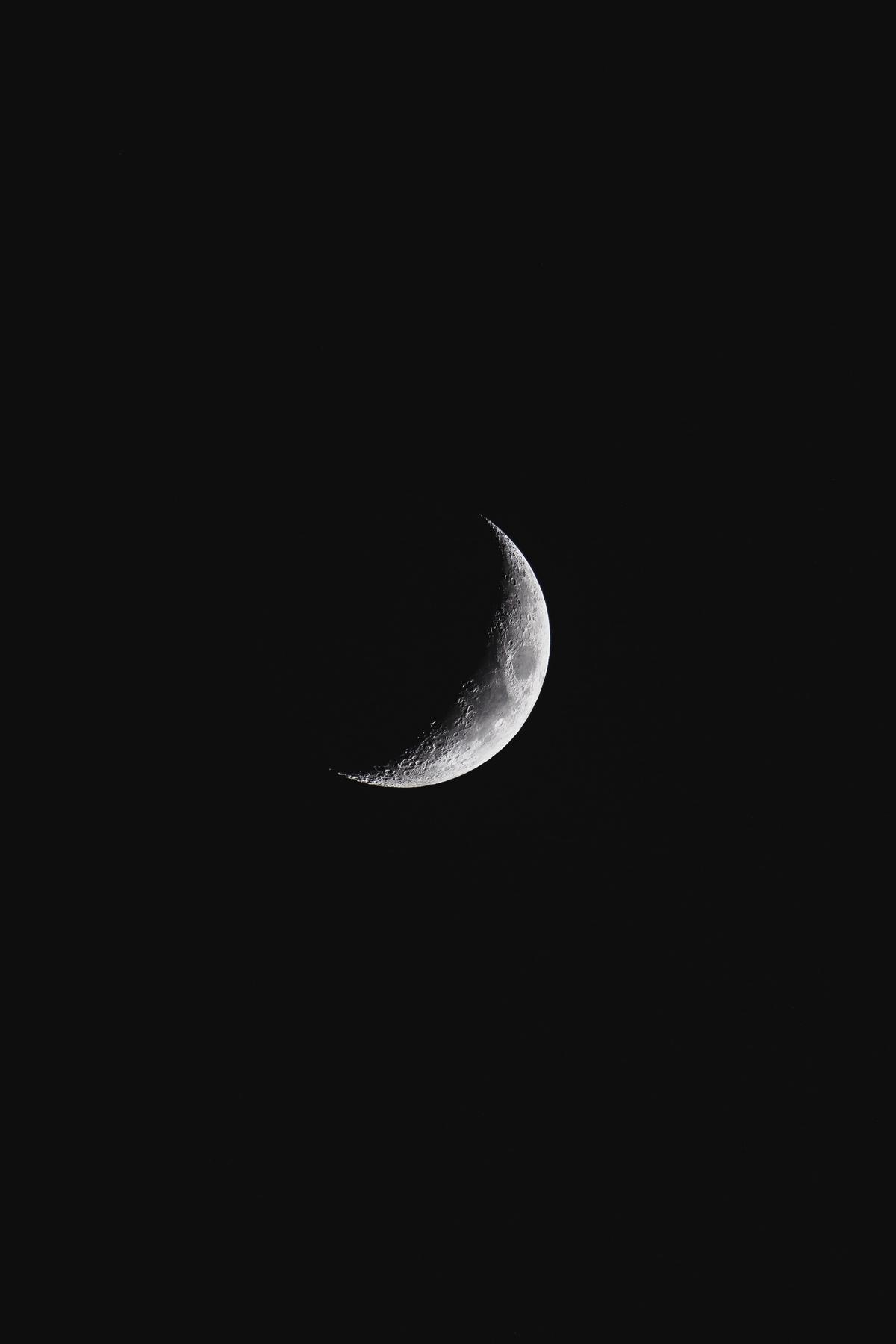
Understanding how the Moon’s phases operate isn’t merely an astronomical hobby, it’s an opportunity to appreciate our natural world’s intricate clockwork. The celestial dance plays out predictably month after month, with highlights including the New Moon’s subtle emergence, the First Quarter’s half-lit precision, the Full Moon’s luminous dominance, and the Last Quarter’s slow retreat. As we chart the Moon’s transitions through September 2023, let’s remember the ancient mariners guided by these celestial signals and cultures that paid homage to its cyclical beauty. This isn’t just an astronomical event; it’s a timeless spectacle licensing mankind into part of the cosmos’ great, marching rhythm. Get ready for a detailed astronautical expedition, prepare your binoculars, chart the lunar calendar, and embark on this moonlit journey that beautifully taps into nature’s rhythm and our rich societal tapestry.
FAQ
What are the moons stages?
As it round the Earth, the moon goes through several phases that together create an enthralling celestial dance known as its lunar phases or moon phases. The different locations of the sun, moon, and Earth in respect to one another cause these phases. The New Moon, when it is positioned between the Earth and the sun and shows its dark side, marks the beginning of the moon’s cycle. The phases of the moon are Waxing Crescent, First Quarter, Waxing Gibbous, Full Moon, Waning Gibbous, Third Quarter, and Waning Crescent as it moves through its orbit. The amount of the moon that is visible from Earth is lighted throughout each phase. The lighted area grows during the Waxing phases and reaches its maximum during the Full Moon. On the other hand, the luminous area gets progressively less during the Waning phases until it reaches the New Moon again. For generations, viewers have been captivated by the moon’s cyclical changes in appearance, which add to the myriad of celestial marvels that adorn the night sky.
What is moon phase Day?
No particular idea is commonly recognized as “moon phase day.” The phrase might, however, also be used slangly to describe a specific day in the lunar cycle when the moon appears at a certain phase, like the Full Moon or New Moon. Because of the moon’s remarkable appearance—or, in the case of the New Moon, its brief withdrawal from view—these times in the lunar cycle are frequently regarded as noteworthy. An individual’s relationship to lunar cycles may be indicated by using the term “moon phase day” in a more symbolic or personal context. This could involve personal thoughts, rituals, or celebrations timed to coincide with the moon’s phases. A deeper understanding of the term’s meaning would result from being aware of the particular context in which it is employed.
Does a full moon last 3 days?
Generally speaking, the phrase “Full Moon” describes the precise moment when the moon is fully illuminated; this moment is very short, lasting only a millisecond. Still, a nearly full moon’s visual appearance might last for a few days, resulting in a noticeable phase that is sometimes called the “full moon phase.” This lasts for around three days, during which the moon appears almost completely lighted on the days preceding, following, and following the real Full Moon. The moon’s slow orbital movement is what causes this phenomenon, as it gradually shifts its distance from the sun and Earth. Sky watchers will have three days to experience the visual impact and brightness of a nearly full moon, giving them plenty of opportunity to take in the lunar spectacle even though the moment of full illumination is brief.
Does a full moon last all night?
Yes, you can see the Full Moon the entire night. When the moon is in an oppositional position to the sun, its completely lighted side faces Earth, and this is known as the Full Moon. Because of this alignment, the moon rises in the east when the sun sets in the west, reaches its zenith at midnight, and sets in the west when the sun rises again. Because of this, the lunar surface is illuminated by the sun’s direct light on Full Moon nights, resulting in a brilliant and luminous display that is visible all night long. Due to its prolonged appearance, the Full Moon is a prominent and alluring aspect in many cultures and traditions, frequently serving as a source of inspiration for wonder and awe.
Is every 14 days a full moon?
No, there isn’t a full moon every fourteen days. The moon takes around 29.5 days to complete one orbit around the Earth, which is known as the lunar cycle. Approximately on the fourteenth or fifteenth day of this cycle, there is a Full Moon. The exact timing, though, varies and isn’t always every 14 days. The moon’s eccentric orbit and the gravitational pull of the sun and other celestial bodies are the causes of the variations. The lunar cycle lasts around 29.5 days, with the phases New Moon, Waxing Crescent, First Quarter, Waxing Gibbous, Full Moon, Waning Gibbous, Last Quarter, and Waning Crescent coming next. Consequently, rather than precisely occurring every 14 days, a Full Moon happens every 29.5 days on average.
How long is a lunar month?
A lunar month, sometimes referred to as a synodic month, is the length of time the moon takes to get from one new moon to the next. The duration of this phase is roughly 29.5 days. The moon’s elliptical orbit around the Earth accounts for the variance in a lunar month’s duration. During this period, the moon goes through several phases: Waxing Crescent, First Quarter, Waxing Gibbous, Full Moon, Waning Gibbous, Last Quarter, and Waning Crescent. At the end of each phase, the cycle is restarted. Throughout history, the lunar month has influenced religious observances, agricultural practices, and social rituals. It is a key unit of time utilized in many calendars and cultural traditions.
What is a half moon called?
Depending on where it is in the lunar cycle, a half moon is often referred to as the First Quarter Moon or the Last Quarter Moon. About a week following the New Moon, there is a First Quarter Moon, which is distinguished by half of the moon’s face being illuminated, giving the appearance of a right-angled semicircle. On the other hand, the Last Quarter Moon, which illuminates the left-angled semicircle, happens approximately one week prior to the subsequent New Moon. It’s important to remember that, despite the phrase “half moon,” the moon is never actually half-lit during these phases; rather, our view of the moon, Earth, and sun during certain periods in the lunar cycle causes it to appear that way.
How does a full moon affect females?
Though there is little scientific proof to back up these assertions, mythology and traditional traditions have long held that a Full Moon may have noticeable impacts on people, especially on women. According to certain myths and customs, the lunar cycle—and the Full Moon in particular—may have an impact on women’s menstrual cycles, moods, and sleep habits. But thorough scientific research hasn’t always been able to prove a clear-cut relationship between lunar phases and behavior. Although the moon’s gravitational pull affects Earth’s tides, it has very little impact on individual people. It’s important to approach these theories critically, understanding that reports of the supposed effects of a full moon on women are frequently anecdotal or based on cultural beliefs rather than observations supported by science.
![]()
